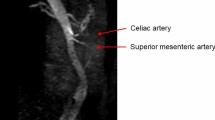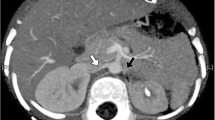Abstract
We describe a 19-year-old man who developed muscle weakness due to hypokalemia. His blood pressure on admission was considered to be relatively high, and we performed captopril renography. His baseline renogram was normal, while the results of captopril renography showed delayed patterns similar to those of renovascular hypertension. However, his blood pressure level decreased and returned to the normal range without medication 2 weeks after admission. Our final diagnosis in this patient was Barter's syndrome. We speculate that the delayed pattern of captopril renography was due to an imbalance between the prostaglandin and the renin-angiotensin systems. The blockade of the renin-angiotensin system by captopril may cause dominant prostaglandins, produce systemic vasodilatory effects, and lead to hypoperfusion of the kidneys in patients with Bartter's syndrome.
Similar content being viewed by others
Author information
Authors and Affiliations
Additional information
Received: January 29, 2002 / Accepted: April 11, 2002
About this article
Cite this article
Suzuki, T., Nangaku, M., Oku, S. et al. Captopril renography in Bartter's syndrome. Clin Exp Nephrol 6, 163–165 (2002). https://doi.org/10.1007/s101570200028
Published:
Issue Date:
DOI: https://doi.org/10.1007/s101570200028




